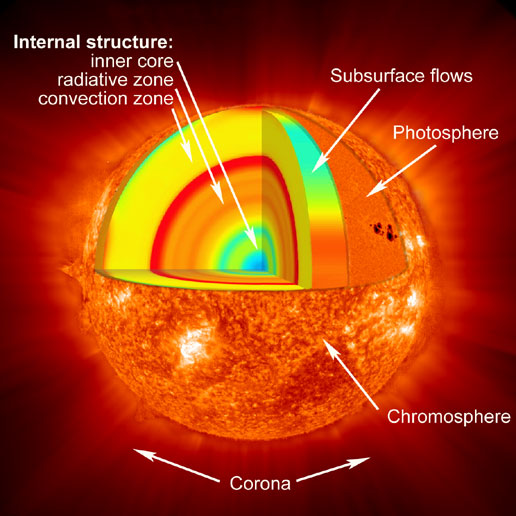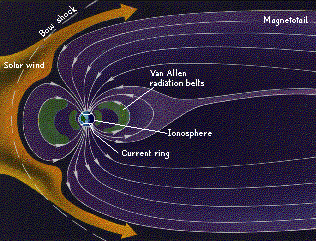Core The innermost layer of the sun is the core which is 10 times denser than lead. Most people expect the core to be solid but the 15 million kelvins in temperature cause it to remain as a gas.Solar Envelope Outside the core is the Solar envelope. The temperature is 4 million kelvins. The density is much less than the core. The solar envelope puts pressure on the core to maintain the heat. It starts to become less efficient for energy to move by radiation so heat energy starts to build up. The energy moves by convection, circulating around the solar envelope. Photosphere The Photosphere is the next layer of the sun. It is a relatively thin layer of low pressure gas which surrounds the solar envelope. It is only about 100 kilometers thick with a temperature of 6000 Kelvins. This is where the sunlight we can see comes from. Chromosphere The Chomosphere is the next layer of the sun and we can sometimes see it during an eclipse. There is a dark red circle around the sun and the colouring is caused by the huge amounts of hydrogen stored there. Corona The final layer is the Corona. It is a low density cloud of plasma which is also only visible during an eclipse. The corona is a lot larger than any other layer. Its temperature ranges from 1 million to 3 million Kelvins. The temperature decreases as the energy moves away from the core but then it increases at the Photosphere. There have been many scientific theories about it but none have been proven. | Sunspots
Sunspots are dark spots on the Photosphere. They have a cooler temperature of 4500 Kelvins as opposed to the 6000 Kelvins inside the Photosphere. Sunspots are caused when the magnetic field of the sun slows down the convection and causes spots to cool. Sunspots come in cycles known as a solar cycle. Solar Flare Inside the corona, above sunspots and areas of intense magnetic field activity, are solar flares. These explosions of energy have been recorded at temperatures of 11 million Kelvins. The heat produces X-rays that create light when they hit the gases in the corona. Prominences A Prominence is generally less violent than a solar flare. It is a cooler sheet of gas which pushes the corona outwards. There are times when they explode violently and rain matter down onto the photosphere. Coronal Mass Ejection Magnetic fields collide and snap apart causing a massive release of energy and solar winds out into space. CME's usually occur around the same time as solar flares. When the explosion is directed at Earth it can cause a geomagnetic storm which can compress the Earths' magnetosphere, causing shorter days and longer nights. This causes spectacular northern and southern lights. The Earth eventually balances itself out after a few days. |

Solar Winds The Solar corona contains many particles. The Suns magnetic field holds these in place but every now and again they slip through the suns magnetic field and propel themselves towards the Earths' magnetic field. |  UV Radiation
The Sun emits three kinds of light, visible light, infrared light and ultraviolet light. Visible light is the light that enables you too see. Infrared light is the light that you can feel burning your skin and ultraviolet light is a form of radiation. There are three types of UV radiation. UV A, which is responsible for the ageing of your skin and can also cause skin cancer. UV B, which is stronger then UV A and burns the skin. It causes sunburn as well as skin cancer. UV C, which is the strongest form of radiation, however it gets blocked by the Earths atmosphere. Sunscreens are used to protect your skin from the suns harmful UV rays but are all sunscreens good for you? A scientific study has shown that nano particles used inside some sunscreens can attack the cells of a person's skin and actually cause skin cancer. The best type of sunscreen is a product with physical blocking agents like zinc and titanium. |